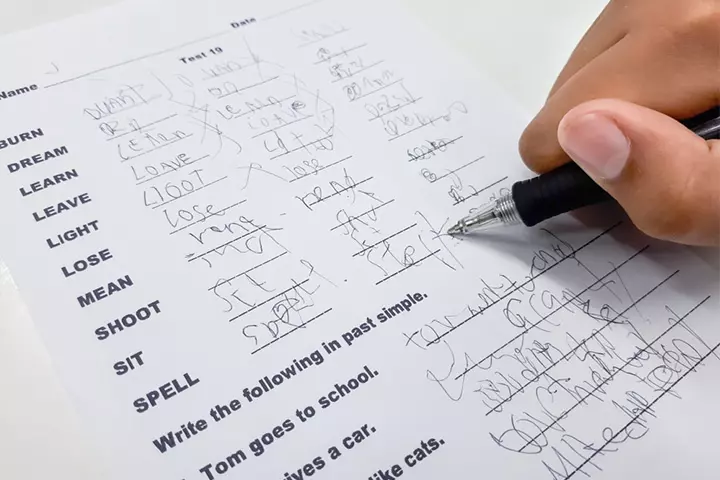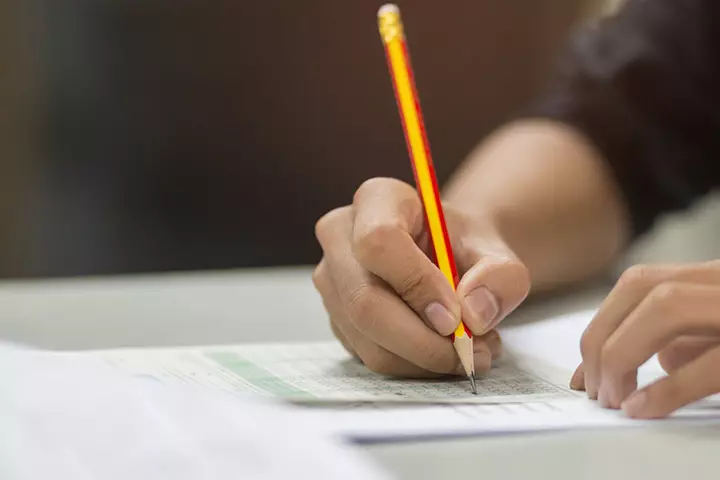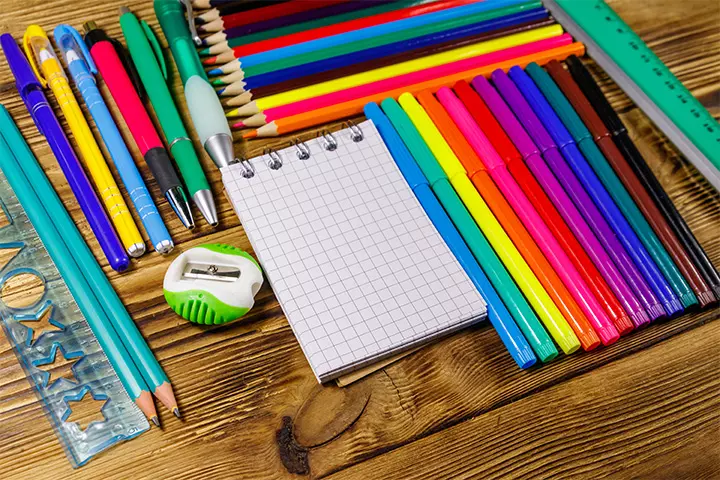
Image: Shutterstock
Good handwriting for teenagers may help increase their chances of getting good grades. Despite digitalization in most sectors of life, good handwriting plays a pivotal role in the education system. For example, most assessments at school need students to write instead of typing. Poor handwriting may make it difficult for the examiner to decipher the content, negatively impacting a student’s grades.

If you are one of several parents who are concerned about your teen’s poor handwriting, this post will help you know about the root cause of your teen’s bad handwriting. We also provide you with some tips on how to help your teenager improve their handwriting.
Key Pointers
- Your teen may have bad handwriting due to a false grip, lack of guidance, or conditions such as dysgraphia, etc.
- Dyspraxia, Dyslexia, Joint hypermobility syndrome, etc., are other conditions responsible for your teenager’s bad handwriting.
- Figuring out the underlying issue, checking your child’s grip, using handwriting worksheets and lined papers, etc., might improve the handwriting.
Causes Of Bad Handwriting
Understanding the cause of your teenager’s bad handwriting will help you fathom how to deal with it. Here are a few probable reasons that might throw some light on why your teen has bad handwriting.
1. Wrong grip

The correct pencil grip plays a huge role in developing good handwriting. The thumb, index finger, and middle finger together form the dynamic tripod grip, which is the correct way of holding a pencil. An incorrect grip may cause the hand muscles to tire out faster compared to the correct grip. This may cause the children to struggle with their handwriting.
2. Lack of guidance
Developing the skill of writing legibly requires proper guidance and support from teachers and parents. Children have to be taught how to write correctly and legibly in the classroom and at home. Unfortunately, in this age of technology, this skill is often considered unimportant and is neglected. Often, teachers and parents are not trained to teach children the skill of writing legibly, and thus, are unable to guide them properly. As a result, children develop an incorrect grip and a poor writing style, resulting in bad handwriting
3. Inadequate practice
It requires consistent practice to get neat and legible handwriting. Children have to invest time in learning the letters of the alphabet and then progress to writing words, phrases, and sentences and alphabetizing things by specific parameters. This has to be done regularly under appropriate guidance.
4. Writing on books with single lines or no lines
Children should be encouraged to practice writing on three-lined handwriting sheets early on. These sheets have a top and bottom line and a dashed middle line to help children understand where to start and end any letter. Using a single line, double line, or blank sheet might make it difficult for them to write in a straight line.
5. Acquiring bad habits and techniques
Children tend to acquire many bad habits from their peers. These habits, if done repeatedly, grow with them into adulthood. If children see their peers slouching, keeping their head on the table while writing, or holding the pencil by wrapping the thumb around it, they might pick up these habits.
Sometimes, you are taught wrong things early on, which causes problems later. For instance, some children write a letter from the bottom line to the top line on a lined page. However, this causes the letters from the upper line to link with the letters from the lower line, causing the handwriting to look untidy.
6. Dysgraphia

Dysgraphia is a learning disability that affects one’s fine motor skillsiAbilities where one needs to use the small muscles in their hands, fingers, and wrists to perform specific movements. and the ability to write. It also impacts spelling, legibility, expression, word spacing, and sizing while writing. Children with dysgraphia face difficulty articulating thoughts on paper, forming shapes of letters, and staying within the margins. This neurological conditioniConditions that impact the brain and the nervous system. can be a major reason for your child’s messy handwriting (1).
 Quick fact
Quick fact7. Dyspraxia
Dyspraxia, also known as developmental coordination disorder (DCD), is a neurological disorder that impacts fine and gross motor skillsi Abilities that allow one to perform tasks by engaging the large muscles in the legs, arms, and torso. , perception, memory, attention, and social skills (2). Children suffering from this condition have poor handwriting (3). They also face trouble in copying from the blackboard. Ed Zitron, a writer, shares his difficult handwriting experience because of this condition. Dyspraxia made him think that he was stupid and a failure. He says, “When I was a kid, I was diagnosed with a condition called dyspraxia — a motor-coordinational learning disability that means that writing by hand, while also incredibly hard to read, is both physically and mentally painful for me. Every time I pick up a pen to write something longer than a sentence I feel genuinely frustrated, the signals from my brain to my hand never quite syncing up, with every letter feeling like a nasty little picture that reminds me that I am, on some level, quite broken. And, unsurprisingly, this led to incredibly bad grades in secondary school whenever I was faced with writing at length — I’d leave exams feeling mentally exhausted, and knowing I’d failed (i).
8. Dyslexia
Dyslexia is a learning disability that affects the areas of the brain that process language. Children learn to read by connecting the words on the sheet with the sounds these words produce. They then reconstruct the patterns of letters in the words while writing. However, individuals with dyslexia find it difficult to decipher these patterns and make the links. Thus, they may find it difficult to acquire the rhythmic flow or movement while writing, which causes handwriting difficulties (4) (5).
9. Joint hypermobility syndrome
Joint hypermobility syndrome is a condition in which the joints are extra flexible and can move beyond the normal range.
The joints in such individuals are loosely supported, and thus, require more effort to maintain positions. This may cause them to suffer from muscle fatigue and pain as well as poor coordination and balance. This pain may cause the affected individuals to face issues with their handwriting (6). Children with this condition may also face problems with pencil/pen grip, impacting their handwriting.
Note: If your child has any of the conditions mentioned above, help them learn at their own pace, and do not compare their progress with that of other children.
Tips To Improve Handwriting
Now that you have understood the causes of poor handwriting in teens, here are a few tips that might help your teen improve this essential life skill.
1. Figure out the issues
Before taking steps towards improving handwriting, it is crucial to understand the exact cause of your teen’s poor handwriting. This way, your teen can put in consistent efforts in the right direction. To figure out the issues, ask them to pen their thoughts or copy a passage from any book in a notebook. Check the writing objectively. Are the letters too slant? Do the letters blend such that it is difficult to distinguish between them? Is the handwriting too big or too small? Is the spacing between the letters or words too less or too much? Assessing all these will give you an understanding of the primary issues in your teen’s handwriting. You can then guide them towards perfecting it.
 Research finds
Research finds2. Check the grip

Often, the grip is the key reason for your teen’s poor handwriting. Check if your teen is holding the pen or pencil in the suggested tripod grip, that is, with the thumb, middle finger, and index finger. The thumb has to be slightly bent, with the index finger on the front of the pencil and the middle finger on the side. Sometimes teens tend to hold the pen/pencil too tight, which fatigues the hand and results in poor handwriting.
So, ensure the grip is firm but not too tight. Applying too much pressure on the paper is another issue that can cause messy handwriting. Keep an eye on the pressure your teen applies while writing, and instruct them to ease out whenever it seems more than necessary.
3. Pay attention to their posture
Research shows that good posture reflects a focused and clear state of mind, while poor sitting posture leads to messy handwriting, which can significantly impact a child’s academic performance (9). Correct posture can help improve handwriting significantly. Check your teen’s posture when they are writing. Their back should be straight; the feet should be well supported; the hips, knees, and ankles should be inclined at an angle of 90 degrees; and the desk should be at the waist height, a degree or two higher than the height of their bent elbows.
Moreover, the paper must be secured by the non-dominant hand and tilted slightly towards the dominant hand. The proper posture helps distribute the muscle strain evenly across the body and prevents joint fatigue and pain.
4. Choose the correct writing tool

Selecting the most suitable writing tool is crucial for good handwriting. Teens generally have to use pens to write. Choose a pen by checking the grip, width, tip, and smoothness. You can find many pens with a dedicated rubber grip that aids in reducing pressure. Check several pens and select the one that you find most comfortable for writing.
5. Use handwriting worksheets and lined papers
Handwriting can be significantly improved by using cursive writing worksheets. These are easily available and can be used to practice handwriting regularly. Using these sheets will build their confidence, improve their penmanship, and help them achieve perfection in writing legibly.
Another helpful tool is the lined papers. A lined paper helps in maintaining consistent letter size and ensures your child writes in a straight line. The margins on the sides aid in writing neatly. A lined paper can be used as a guide even while writing on a blank paper. Keep the lined paper below the blank paper and use the visible lines to write with precision.
6. Check their knowledge of cursive rules
Sometimes, teens do not pick up the cursive handwriting rules well in school and write erratically. This results in an inconsistent writing style that looks messy. Help your child understand the basic rules of cursive writing and encourage them to practice. Introducing your teen to cursive workbooks and exercises can help them learn the style at a faster rate. They can then practice by copying short passages in cursive and gradually move on to larger passages.
7. Strengthen the hand muscles

We use the muscles of the hands, fingers, palm, and wrist while writing. Strengthening these muscles will increase the stamina for writing and prevent the muscles from getting fatigued too soon. Encourage them to work on their fine motor skills. Simple activities such as sewing, knitting, coloring, playing hand-eye coordination board games, stringing beads, kneading, or playing with dough can improve their fine motor skills.
Certain tools, such as scissors or screwdrivers, also help improve the agility of the fingers. Building upper body strength, especially the shoulders and forearms, also plays a key role in developing good handwriting. So, persuade your teens to participate in activities such as swimming and climbing.
8. Encourage them to write slowly and purposefully
When writing fast, all your focus is on the speed, which causes you to neglect the handwriting. Writing slowly would help your teen pay attention to their grip and hand movement and write each letter consciously. Once they start writing neatly, teach them how to slowly increase their speed without impacting the quality of the handwriting. With time and practice, your child would be able to write at a considerable pace.
This activity can be made more fun by allowing them to write on the topics of their choice, giving them the right writing accessories, and encouraging them to do crossword puzzles or anagrams.
9. Make them practice every day
The adage, practice makes perfect, is especially true for improving handwriting. Teach your teen to invest some time in handwriting practice every day. Sit with them and help them understand the writing issues that they need to work on.
You could also motivate your child by gifting them a diary. Encourage your teen to pen down their thoughts and activities in this diary regularly and purposefully while ensuring they use cursive rules. This journaling practice would make the journey of handwriting improvement exciting.
 Did you know?
Did you know?10. Put in the effort and keep their spirits up
Improving handwriting requires considerable time and effort. At times, this might impact the morale of your teen. Hence, it is crucial to be gentle and appreciate their efforts. Compliment them whenever they show improvement and gently point out the issues.
Scolding your teen or pressurizing them repeatedly can put undue strain on them and negatively impact their progress. It is important to maintain a positive environment to boost learning. Whenever your teen is bored or tired, take a short break. These breaks will rejuvenate them and help them get back to practice with more enthusiasm.
Traits Of Good Handwriting Style
A well-developed handwriting style enhances readability and communication. It ensures that written words convey their intended message effectively. Following are some key traits that characterize good handwriting.
- Distinct letter: Each letter should be distinct and easily recognizable. For example, ‘a’ should not resemble ‘o,’ and ‘r’ should not look like ‘v.’ Properly formed letters help ensure that words can be read effortlessly without misinterpretation.
- Consistency in size: All the letters should be of the same size. Their spacing also should be uniform to make the copy look neat and readable. Proper alignment is necessary, with notes on the baseline and uniform line spacing maintained.
- Proper alignment of letters: Good handwriting follows an imaginary baseline, meaning letters should rest evenly on the writing line rather than floating above or dipping below unpredictably. Proper alignment ensures that writing remains structured and visually appealing.
- Smooth pen stroke: A smooth and controlled movement of the pen helps to create a natural and flowing handwriting style. Choppy or irregular strokes can make writing appear unsteady and disjointed. Fluidity in handwriting allows for a seamless connection between letters, especially in cursive writing, making it easier to write faster while maintaining legibility.
Additionally, an individual’s unique flair or personality can be expressed through handwriting while adhering to legibility and consistency. Mastery of these traits enhances the appearance of writing and improves communication effectiveness.
Frequently Asked Questions
1. Can handwriting be improved at any age?
A person’s handwriting can be improved at any age with the right techniques and consistent practice. Everyone can further refine their handwriting if they decide to make it better with practice.
2. What are the advantages of having good handwriting?
Good handwriting improves confidence, motivates the writer, and reflects their character. It also helps improve recall and memory.
3. Is handwriting related to IQ?
Handwriting is a motor skill that requires fine motor control and coordination, whereas IQ (intelligence quotient) is a measure of cognitive abilities such as reasoning, problem-solving, and memory. There is no scientific evidence to prove a direct correlation between handwriting and IQ.
4. What digital tools can help improve my teen’s handwriting?
Consider digital tools like LCD writing tablets or touch-screen tablets with a stylus. You may also find apps designed to work with a stylus to help improve a teenager’s handwriting.
Making your teenager practice good handwriting could be a real task at times. As they grow older, good handwriting is essential to make a great impression on their examiners, teachers, peers, and everyone else. It will further boost their confidence and help them succeed in life. Therefore, trying out all the tips can help them refine their handwriting which can make their work readable and look like artistry at the same time. And if you think your child has made progress, the next logical step would be to introduce them to these drawing ideas for teenagers.
Infographic: Ways To Improve Handwriting Of Teenagers
Good handwriting is a reflection of a clear mind. Good and clear handwriting is also crucial for a teen to score well on their exams, make them feel confident, and develop an interest in writing. Here is an infographic with tips to help your teenager improve their handwriting.
Some thing wrong with infographic shortcode. please verify shortcode syntax
Illustration: Practical Tips To Improve Handwriting For Teenagers

Image: Stable Diffusion/MomJunction Design Team
Discover techniques to enhance your handwriting in this video! From grip adjustments to letter formation, unlock secrets to penmanship perfection and elevate your writing effortlessly. Unleash your inner calligrapher!
Personal Experience: Source
MomJunction articles include first-hand experiences to provide you with better insights through real-life narratives. Here are the sources of personal accounts referenced in this article.
i. I was stupid until the computer came along.https://edzitron.medium.com/i-was-stupid-until-the-computer-came-along-5be54c7ba4ed
References
1. About Dysgraphia; UNESCO MGIEP
2. What is dyspraxia?; Dyspraxia USA
3. The difference between dyspraxia and dysgraphia; Understood For All
4. How can I support my child? – Handwriting; The British Dyslexia Association
5. Michael Hebert, et al.; Why Children With Dyslexia Struggle With Writing and How to Help Them; Language, Speech, and Hearing Services in Schools (2018).
6. Lauren Frohlich, et al.; Effects of neoprene wrist/hand splints on handwriting for students with joint hypermobility syndrome: a single system design study; Physical & Occupational Therapy in Pediatrics (2012).
7. Attention Deficit Handwriting Details: The Effects of ADHD on Handwriting; University of Notre Dame
8. James and Engelhardt; The effects of handwriting experience on functional brain development in pre-literate children; Trends Neurosci Educ.(2012)
9. Folorunso Ojo, et al.; Effects Of Sitting Posture And Handwriting On Science Students’ Academic Performance Using An Inquiry -Based Pedagogical Teaching Approach; ResearchGate (2025).
Community Experiences
Join the conversation and become a part of our nurturing community! Share your stories, experiences, and insights to connect with fellow parents.
Read full bio of Beth Sullivan
Read full bio of Advaitaa Ravi
Read full bio of Harshita Makvana
Read full bio of Kavita Kankani
















